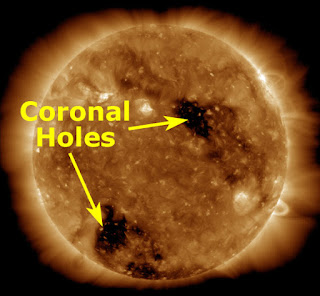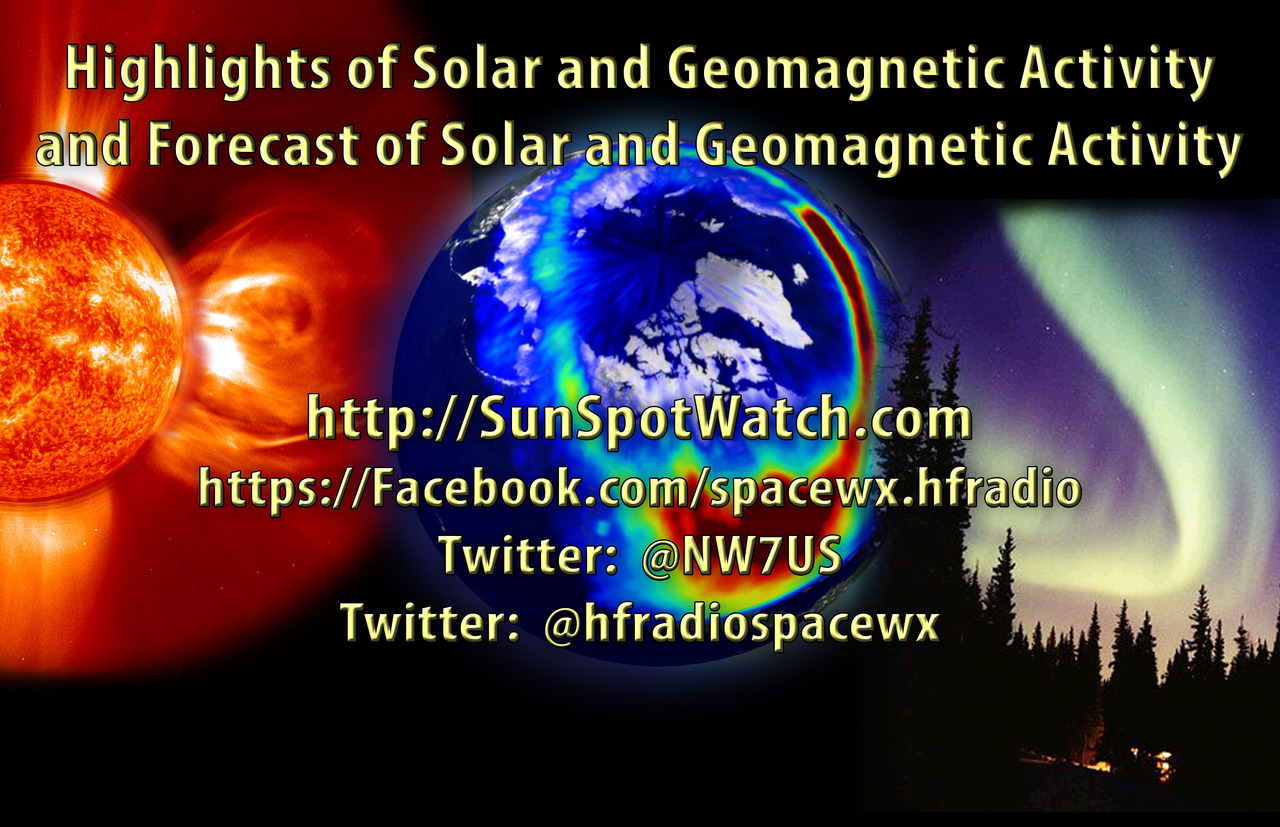 Weekly Propagation Summary – 2018 Oct 01 16:10 UTC
Weekly Propagation Summary – 2018 Oct 01 16:10 UTC
Here is this week’s space weather and geophysical report, issued 2018 Oct 01 0253 UTC.
Highlights of Solar and Geomagnetic Activity 24 – 30 September 2018
Solar activity was at very low levels throughout the period. Region 2723 (S08, L=356 class/area Dro/030 on 30 Sep) developed on 29 Sep, but was already showing signs of decay as of this report, and remained inactive. No Earth-directed CMEs were observed in available satellite imagery.
No proton events were observed at geosynchronous orbit.
The greater than 2 MeV electron flux at geosynchronous orbit reach high levels on 24 – 28 Sep, then decreased to moderate levels on 29 – 30 Sep. A peak flux of 6,202 pfu was observed on 24/2020 UTC.
Geomagnetic field activity was at quiet to unsettled levels throughout the entire period, from 24 – 30 Sep, under very subtle CH HSS influence. Solar wind speeds averaged near 430 km/s through most of the period, but did see an increase to reach a peak of 505 km/s on 30/0158 UTC. Total field strength ranged between 1 nT to 7 nT, while the Bz component was variable between +/- 6 nT through the period.
Forecast of Solar and Geomagnetic Activity 01 October – 27 October 2018
Solar activity is expected to be at very low levels throughout the outlook period, with a slight chance for C-class flare activity.
No proton events are expected at geosynchronous orbit.
The greater than 2 MeV electron flux at geosynchronous orbit is expected to be at moderate levels from 1 – 8 Oct, and again from 26 – 27 Oct. High levels are expected from 9 – 25 Oct following elevated solar wind speeds associated to recurrent CH HSS activity.
Geomagnetic field activity is expected to be at quiet to unsettled levels from 1 – 6 Oct, with isolated active levels likely on 1 Oct. Conditions are then expected to reach G1 (Minor) storm levels on 7 – 8 Oct, with G2 (Moderate) storm levels likely on 8 Oct, due to a positive polarity CH HSS. A brief return to unsettled levels is likely on 9 Oct, with G1 (Minor) storm levels likely returning on 10 Oct as CH HSS effects persist. Active levels are expected on 11 Oct as CH HSS effects taper off. Mostly quiet to unsettled levels are expected from 12 – 18 Oct, with isolated active periods likely on 14 and 18 Oct. G1 levels are likely again on 19 Oct as another CH HSS influences the magnetic field. Isolated active periods are expected early on 20 Oct before conditions decrease to be at mostly unsettled levels throughout the remainder of the outlook period (21 – 27 Oct) as CH HSS effects continue to wane.
Don’t forget to visit our live space weather and radio propagation web site, at: http://SunSpotWatch.com/
Live Aurora mapping is at http://aurora.sunspotwatch.com/
If you are on Twitter, please follow these two users: 1. https://Twitter.com/NW7US 2. https://Twitter.com/hfradiospacewx
– – – – – – – – – – – – –
Be sure to subscribe to our space weather and propagation email group, on Groups.io
https://groups.io/g/propagation-and-space-weather
Spread the word!
– – – – – – – – – – – – –
Links of interest:
+ Amazon space weather books: http://g.nw7us.us/fbssw-aSWSC
+ https://Twitter.com/NW7US
+ https://Twitter.com/hfradiospacewx
Space Weather and Ham Radio YouTube Channel News:
I am working on launching a YouTube channel overhaul, that includes series of videos about space weather, radio signal propagation, and more.
Additionally, I am working on improving the educational efforts via the email, Facebook, YouTube, Tumblr, and other activities.
You can help!
Please consider becoming a Patron of these space weather and radio communications services, beginning with the YouTube channel:
https://www.patreon.com/NW7US
The YouTube channel:
https://YouTube.com/NW7US
..
Visit, subscribe: NW7US Radio Communications and Propagation YouTube Channel
 Ham College 45
Ham College 45
Ham College episode 45 is now available for download.
General Amateur Radio Exam part 16. More Skywaves and more HF Antennas.
01:24:31
Download
YouTube
George Thomas, W5JDX, is co-host of AmateurLogic.TV, an original amateur radio video program hosted by George Thomas (W5JDX), Tommy Martin (N5ZNO), Peter Berrett (VK3PB), and Emile Diodene (KE5QKR). Contact him at george@amateurlogic.tv.
 ICQ Podcast Episode 277 – The Classic Bird 43 Wattmeter
ICQ Podcast Episode 277 – The Classic Bird 43 Wattmeter
In this episode, Martin M1MRB is joined by Chris Howard M0TCH, Dan Romanchik KB6NU, Martin Rothwell M0SGL, Ed Durrant DD5LP and Frank Howell K4FMH to discuss the latest Amateur / Ham Radio news. Colin M6BOY rounds up the news in brief, and this episode’s feature is - The Classic Bird 43 Wattmeter.
ICQ AMATEUR/HAM RADIO PODCAST DONORS
We would like to thank David Hartley (RS314170), Philip Heckingbottom (VK6ADF) and an anonymous donation and our monthly and annual subscription donors for keeping the podcast advert free. To donate, please visit - http://www.icqpodcast.com/donate
- EI Station Works Japan on 70cms Moonbounce for EI First
- Moon Bounce on a Dipole
- Ofcom Issues M5 prefix Calls Again
- Spectrum Management and the Impact on Amateur Radio
- FCC to Impose Two-Way VHF/UHF Radio Restrictions
- Swedish Amateur Radio Regulation Changes
- Russia Proposes DRM on 65.9-74.0 MHz
- ExseedSat Ham Radio FM Transponder Satellite
Colin Butler, M6BOY, is the host of the ICQ Podcast, a weekly radio show about Amateur Radio. Contact him at info@icqpodcast.com.
 SOTA Activation: Mount Emma or Emma Burr Mountain (W0C/SP-127)
SOTA Activation: Mount Emma or Emma Burr Mountain (W0C/SP-127)
There is a SOTA (Summits On The Air) summit just north of Tincup Pass with an elevation of 13,538 feet. The SOTA database (W0C/SP-127) says the name is Mount Emma but all of my maps indicate that it is Emma Burr Mountain. (I contacted the W0C Association Manager and we’re working it out.)
Joyce/K0JJW and I did the first activation of this summit in late September. The weather was wonderful except for the wind that pounded us anytime we were exposed on a ridgeline, which is to say it happened a lot. We started our ascent from Tincup Pass, which is at 12,154 feet on the Continental Divide (see photo). I’ve seen trip reports of people hiking this summit from the northeast (Mineral Creek area) accessible by South Cottonwood Road (FS 344), so that may be another option.

At Tincup Pass, there is an obvious trail leading off the the east. We followed this trail uphill for a while and then diverted off to the north towards the north/south ridgeline and Tincup Peak. Tincup Peak is not a SOTA summit and is not shown on all maps. It is a13,345 foot bump on the ridge heading north. Our entire hike followed the Continental Divide, always a real treat.

We followed the top of the ridge for the most part, occasionally dropping down a bit on the west side to avoid obstacles. Occasionally we followed a faint trail but for the most part this was off-trail hiking, often with significant rocks to climb over.

Once we got on top of the ridgeline, we could see our actual objective of Emma Burr (see photo below). The saddle between Tincup Peak and Emma Burr dropped down more than I expected from viewing the topo map, so we soon realized that we’d have to lose substantial elevation and then climb to get it back. Oh, well.

Once on the summit of Emma Burr, I pulled out the 2m FM station and started calling CQ on 146.52 MHz. We had no mobile phone coverage at Tincup Pass but once we got on the ridge, Verizon was working pretty well so I spotted us on Sotawatch. Our best DX was Dave/N0KM near Center, CO for a distance of 70 miles. Other stations worked: W0BV, W0RW, N1TEW, K0MGL, K0TG, KB0QEP, KL7GLK, N0EVH, KD0VHD and W0DLE. Lots of stations on 2m FM that day. I tried working W0RW on 1.2 GHz FM but we could not quite make it. I definitely heard him right at the noise floor but my 1 watt signal was not readable on his end.

My GPS app on the smartphone says that the one-way climb is 2.4 miles with 1600 vertical feet. The elevation difference between Tincup Pass (12,154) and Emma Burr (13,538) is 1384 feet, but the saddle costs you another 300 vertical feet of climbing.
Overall, it was a great day in the mountains. We knocked out two 13ers in one day and did a first SOTA activation. However, the wind pounded us quite well so we were plenty tired when we got back to our vehicle.
73 Bob K0NR
The post SOTA Activation: Mount Emma or Emma Burr Mountain (W0C/SP-127) appeared first on The KØNR Radio Site.
Bob Witte, KØNR, is a regular contributor to AmateurRadio.com and writes from Colorado, USA. Contact him at bob@k0nr.com.
 LHS Episode #249: The Weekender XVI
LHS Episode #249: The Weekender XVI
 Hello and welcome to the 249th installment of Linux in the Ham Shack. You've found our Weekender edition. In this episode, we discuss upcoming amateur radio events and special event stations active over the next couple of weeks. We also touch on Open Source conferences, including the venerable Ohio Linux Fest, as well as give you distros to try, challenges to exercise your brain and a bit of hedonism to calm it back down again. Thank you for listening.
Hello and welcome to the 249th installment of Linux in the Ham Shack. You've found our Weekender edition. In this episode, we discuss upcoming amateur radio events and special event stations active over the next couple of weeks. We also touch on Open Source conferences, including the venerable Ohio Linux Fest, as well as give you distros to try, challenges to exercise your brain and a bit of hedonism to calm it back down again. Thank you for listening.
73 de The LHS Crew
Russ Woodman, K5TUX, co-hosts the Linux in the Ham Shack podcast which is available for download in both MP3 and OGG audio format. Contact him at russ@bluecows.com.
 CLE236 Results
CLE236 Results
 |
| courtesy: https://sdo.gsfc.nasa.gov/ |
It seems that for the CLE236 listeners in western North America, my worst fears came true. The week preceding last weekend's listening event had seen great MF propagation and quiet geomagnetic conditions.
On Friday evening, shortly after the start, a geomagnetic storm commenced, with K-levels reaching 5-7 at various stations ... pretty much sounding the death knell once again. It seems more than coincidental that almost every CLE in the past few years has seen horrific geomagnetic conditions in lock-step with our scheduled monthly events!
Since there were no active regions on the Sun at the time, I suspect, as mentioned in my last blog, that we were victimized by a sudden spurt from the same coronal hole that whacked us last month, as it lined-up once again on its monthly reappearance. Arriving on Friday evening as sunset approached, the effects seemed to spare the rest of North America (and Europe), as western listeners were the only ones reporting poor propagation. As well, lightning noise, often abating by this time of the year, created havoc for many listeners ... even those with good propagation.
I can only hope that next month's event will see a major improvement in noise levels as well as in propagation quality. Hopefully, that pesky coronal hole will have closed itself by then!
On top of the above mentioned challenges, CLE236's frequency range was smack on top of my local pest, AP-378, whose antenna is less than one mile from my own antennas. Having an S9 +60db signal in the middle of the narrow CLE range does make for challenging listening. My 10' x 20' loop knocked AP's signal down about 25db, allowing me to hear the following signals, some only barely.
See you in CLE237.
Steve McDonald, VE7SL, is a regular contributor to AmateurRadio.com and writes from British Columbia, Canada. Contact him at ve7sl@shaw.ca.
 LHS Episode #248: Release the Krakel
LHS Episode #248: Release the Krakel
 Hello and welcome to Episode #248 of Linux in the Ham Shack. We're so glad you tuned in today. In this episode, we discuss crypto on the airwaves, Hurricane Florence, Sweden price gouging hams, meritocracy and diversity in Open Source, Linus Torvalds, Linux for Windows(??) and much more. Thank you for listening!
Hello and welcome to Episode #248 of Linux in the Ham Shack. We're so glad you tuned in today. In this episode, we discuss crypto on the airwaves, Hurricane Florence, Sweden price gouging hams, meritocracy and diversity in Open Source, Linus Torvalds, Linux for Windows(??) and much more. Thank you for listening!
73 de The LHS Crew
Russ Woodman, K5TUX, co-hosts the Linux in the Ham Shack podcast which is available for download in both MP3 and OGG audio format. Contact him at russ@bluecows.com.














